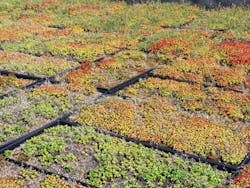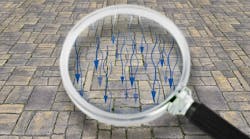Brewing Sustainability
Mary Beth Nevulis is managing editor of SWS. Nevulis can be reached at [email protected].
undefinedAs sustainability becomes more of a buzzword in everyday life, municipalities and utilities are turning to a green or grey-green approach to managing storm water. Milwaukee is one city that is ramping up its green infrastructure and sustainability initiatives, with big efforts from the Milwaukee Metropolitan Sewerage District (MMSD), a utility with a vision: to attain zero overflows, zero basement backups and improved storm water management by 2035. Called the Fresh Coast 740 program, it aims to use green infrastructure to capture 740 million gal of rain, or approximately the first 1/2 in. of rain falling on impervious cover, by 2035.
“When you’re in a densely urbanized area like Milwaukee that is very impervious and also has some combined sewer area, it’s important to relieve some of the stress on our system when the rain starts to pour,” said Matthew Magruder, environmental research manager for MMSD. “We’re finding that it’s much cheaper to implement green infrastructure in a planning phase versus tearing up the ground [later] and putting in more grey infrastructure, and it’s a really good supplement to our conveyance network.”
MMSD has implemented green infrastructure and sustainable operations at its facilities, including solar panels, rain gardens and bioswales, as well as a landfill gas pipeline that goes from Muskego, Wis., to the Jones Island Water Reclamation Facility in Milwaukee, and burns landfill gas to power the district’s operations.
One of MMSD’s biggest initiatives is a green roof test plot atop its headquarters, where a traditional green roof has been in place for 10 years and can hold up to 1,500 gal of water. New additions to this roof will add a retention/detention element, and monitoring is set to begin this year.
Green Roofs as Storm Water Management
A green roof can retain 50% to 90% of a typical precipitation event, depending on media type and depth and drainage material, according to Thomas M. Hanzély, national sales manager for Firestone Building Products’ Skyscape vegetative roof system. A green roof delays or absorbs runoff, decreasing the amount of water that flows into municipal storm systems.
The precipitation is captured and stored in the growing medium and water retention layers of the green roof system. Stored water then is taken up into the vegetation and returned to the atmosphere through transpiration, and water evaporates from the medium. Some precipitation also is captured on the plant foliage.
A green roof is one of a suite of sustainable practices a municipality or utility can employ.
“Green roofs are a municipal best management practice for mitigating both the quantity and quality of runoff caused by changes in the hydrological cycles from site development,” Hanzély said. “Green roofs can also contribute to a reduction in the urban heat island effect created by lessening the abundance of heat-absorbing materials found in larger metropolitan areas, as well as create habitats for birds and insects.”
Hanzély added that the presence of green roofs can help boost rent and selling prices for building owners, reduce hospital stay time for post-surgical patients, and contribute to overall improved quality of life in urban areas by providing natural environments that reduce stress.
MMSD’s Roof
MMSD’s expansive green roof has three new systems being monitored: Hydropack and two types of Stock & Flow, all manufactured by Vegetal i.D.
Hydro Pack is a modular green roof system that Vegetal i.D. developed in 2000. The trays atop the MMSD building measure 2 ft by 1.3 ft at 18 lb per sq ft; trays on a typical green roof are 30 lb per sq ft.
The passive Stock & Flow is a retention system that goes underneath the Hydro Pack. The plastic trays each hold about 2 in. of rainfall in the system and double as a hidden irrigation system. Runoff is controlled through a flow regulator that minimizes peak flow, and outflow can be adjusted to fit site-specific runoff requirements. Within that system, wicking pedestals allow the plants to be irrigated from underneath, using capillary irrigation to maximize onsite retention. The bottom 1/2 in. of each tray is permanently retained within the storm water management system.
“After a rainfall, we drain the remaining water, and we retain enough storm water to irrigate for a period of time after the system has been drained,” said Brennon Garthwait, sales project coordinator for Vegetal i.D. “That’s [something] we’re hoping to see [during the monitoring timeframe]: how long that retention system lasts in different environmental conditions.”
The Smart Stock & Flow is a product still in the works at Vegetal i.D. that is intended to be a part of a smart city; monitoring data from the MMSD test plots may show that it can eliminate runoff entirely during rain events.
“We envision the system to be kind of a decentralized, living deep-tunnel system,” Garthwait said.
Each roof plot measures 10 ft by 15 ft. Researchers at the University of Wisconsin-Milwaukee (UWM) are monitoring the system’s performance and will examine the individual flow rate from each plot after storm events.
“We’ll be looking at the overall retention [and] the temperature in each of those plots to try to get an estimate of urban heat island effect and soil moisture over time, to give us a better idea of … drought tolerance and evapotranspiration,” said Joseph Seidl, a graduate student at UWM participating in the research. “Then we’ll be specifically weighting the plots to try and dial into how much water they’re consuming and tying that into water level in the Stock & Flow units. We’ll also be measuring all that information against a weather station that we’ll put up there to figure out exactly how much rain we got against the flow rates, retention, temperature, ambient temperature, humidity and the like.”
There is little available data on the performance of green roofs, according to Qian Liao, associate professor and chair of the civil engineering and mechanics department at UWM, and one of the researchers. The research conducted using the MMSD test plots can record this data to see how the roof performs under certain conditions, and then determine runoff rate.
“Once we collect a lot of data, we can apply statistical analysis to come up with some basic parameters for the green roof, so, for example, if there is a 10-year storm or 20-year storm that lasts for 6 hours, then based on our data, we would be able to tell the runoff rate coming from this roof—not only for [this] green roof but also on a larger scale,” Liao said. “[We could determine] if we increase the size of the roof by X percent, how much storm water reduction can be achieved or how much of the urban heat island issue can be solved. We are not only monitoring the flow, but also soil moisture, temperature and other parameters, and we can use these to develop hydrological and thermodynamics models, which will be critical in the future to large-scale studies.”
An environmental economist from the University of Wisconsin-Whitewater, Matthew Winden, will calculate the cost-benefit analysis of the roof, and both externalized public benefits and direct public benefits, according to Garthwait. A survey will be sent out to Milwaukee residents to help gauge the public’s perception of green roofs as well as hidden costs and benefits.
“We’ll be scaling things up [to determine] different possibilities for roof coverage in the city and looking at how much that might save taxpayers … but then extending it further by saying, if we’re reducing the temperature of the city by one or two degrees in peak summer months, or if you were to minimize overflow events or improve the water quality of Lake Michigan, how much could you expect to reduce healthcare costs? How would that alter tourism?” Garthwait said. “How much do the citizens of Milwaukee value water quality? If that were to change, could you put a dollar amount on it? I haven’t seen a substantial amount of research in that area and it’s a valuable tool for policy makers.”
Garthwait said that monitoring of the roof will begin in April 2015. “Our goal is to get performance numbers that are solid by fall of 2015,” he said.
Magruder said that the green roof is one part of the larger goal to fulfill MMSD’s 2035 vision.
“It’s a big goal and it sets the bar high, but it keeps MMSD moving in the right direction,” he said. “We don’t feel that grey alone can achieve our goals. We don’t think green alone can, either, but we think together there is a good chance.”
Download: Here


